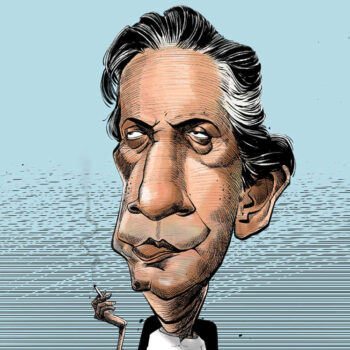
Satyajit Ray, born into a family of painters, illustrators, and storytellers, imbibed the spirit of creativity from his early childhood. Upendrakishore, his grandfather, was among the foremost luminaries of Bengal. Ray inherited the creative genius of his father Sukumar Ray as well. Ray, an honors graduate in Economics, went to Shantiniketan to enroll himself in a course on Visual Arts. With Nandalal Bose and Binodebihari Mukhopadhyay as teachers, Ray’s formative years as an artist were not without events or newer discoveries. Exposed to different styles and genres of art, Ray’s inner expressions were finding an outlet that helped him mature as an artist. Ray joined DJ Keymer, a prominent British ad agency, as a junior visual artist. At DJ Keymer Ray worked with O.C. Ganguly, Purna Chakraborty, Makhan Duttagupta, Samar Ghosh, and Annada Munshi — famous commercial artists whose layout and artworks were the face of many reputed companies. When Satyajit realized that some work were lame copies of foreign advertisements, he tried to incorporate a greater dose of ‘Indianness’. In 1943, DK Gupta, his boss at DJ Keymer, launched Signet, a publishing company that revolutionized publishing. Tukro Katha, the publication’s newsletter, began to carry portraits, headpieces, and illustrations by Ray. The house published many renowned books like Nehru’s Discovery of India, Bibhutibhushan Bandopadhyay’s Chander Pahar, Jibanananda Das’s Rupasi Bangla and Banalata Sen, Saat-ti Taarar Timir etc. Ray was roped in to do most of the covers and illustrations. Signet ushered in a new style, both in terms of visual expression and design. In 1945 Ray famously did the cover of Am Antir Bhenpu, a children’s version of Panther Panchali by Bibhutibhushan Bandopadhyay, which triggered his desire to turn the original novel into a film.) In 1950, he drew cartoonesque doodles for the reprint of one of his father’s books. In 1948, Hate Khari, a book to introduce children to Bengali alphabets, was shaped and drawn like a wooden slate, a novel idea by Ray. 1946 onwards, Ray was contributing artworks for Rongmoshal, edited by his friend Kamakshi Prasad Chattopadhyay. He also drew for another magazine, Patabahar. Ray had a natural flair to visually capture the mood and feel of a story. During his Signet years, Ray could effortlessly give the readers a visual clue to what was about to unfold as they turn the pages of the book. Ray never gave up drawing. In 1961, he revived Sandesh, the family magazine. Sandesh gave Ray an opportunity to go back at his drawing board. He illustrated his own stories as well as many stories by other writers. His covers for the magazine are timeless examples of his graphic sensibilities. Constantly experimenting, using ink and pen, pencil, watercolours and ordinary poster paint in different stylizations, Ray’s illustrations are striking in the way they marry playfulness with strong lines.
In 1971, Ray drew four single-page gags for Sandesh. It was like a silent film, the protagonist being a dhoti-clad average Bengali with neatly parted hair, who runs into trouble every time he engages with a problem. Ray’s foray into comics was, however, short-lived. There are around 5,500 artworks of Ray, in the form of book covers, posters, illustrations, layouts, film titles, and lobby cards. Looking Beyond: Graphics of Satyajit Ray (Roli Books: 2012 ) by Jayanti Sen provides an overview of the considerable body of work that constitutes Ray’s graphic designs.